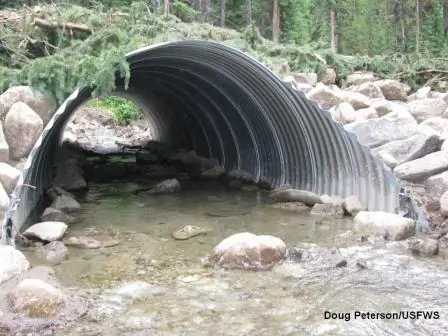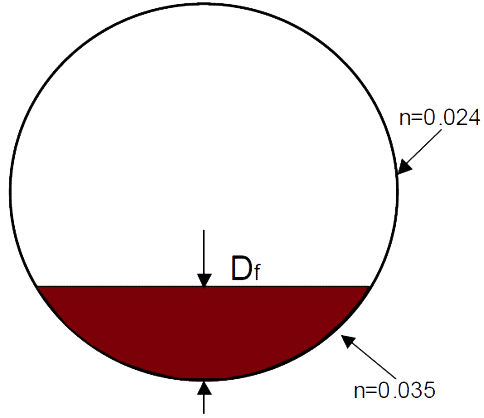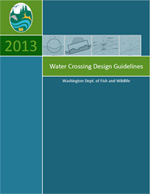This article discusses defining HEC‑RAS culverts for fish passage, by defining multiple roughness regions and partially-buried culverts.

Multiple Roughness Regions
HEC‑RAS allows the user to define two Manning’s roughness values for a culvert, one for the top and sides, and a second for the culvert bottom. The user defines the depth inside the culvert to which the bottom n value is applied. This feature can be used to simulate culverts that have a natural stream bottom, or a culvert that has the bottom portion rougher or smoother than the top, or if something has been placed in the bottom of the culvert to facilitate fish passage. An example of this is shown in the below figure.

When multiple Manning’s n values are applied to a culvert, the computational program will use the bottom n value until the water surface goes above the specified bottom n value. When the water surface goes above the bottom n value depth the program calculates a composite n value for the culvert as a whole. This composite n value is based on an equation from Chow’s book on Open Channel Hydraulics (Chow, 1959) and is the same equation we use for computing a composite n value in open channel flow.
Partially Filled or Buried Culverts
HEC‑RAS allows the bottom portion of the culvert to be filled-in. This option can be applied to any of the culvert shapes. The user is only required to specify the depth to which the culvert bottom is filled-in. An example of this is shown in the below figure.

The user can also specify a different Manning’s n value for the blocked portion of the culvert (the bottom), versus the remainder of the culvert. The user must specify the depth to apply the bottom n value as being equal to or greater than the depth of the filled portion of the culvert.
Design of Culverts for Fish Passage

Date Published: May 09, 2013
Number of Pages: 300
Publisher Information: State of Washington Department of Fish & Wildlife
DESCRIPTION:
This edition of the Water Crossing Design Guidelines document has been completely revised and covers the design of culverts with new chapters on bridge design, tidally influenced crossings, temporary crossings, culvert abandonment, and project development. This document provides practical, real-world knowledge and techniques to improve the overall success of water crossings.
Suggested Citation:
Barnard, R. J., J. Johnson, P. Brooks, K. M. Bates, B. Heiner, J. P. Klavas, D.C. Ponder, P.D. Smith, and P. D. Powers (2013), Water Crossings Design Guidelines, Washington Department of Fish and Wildlife, Olympia, Washington.
